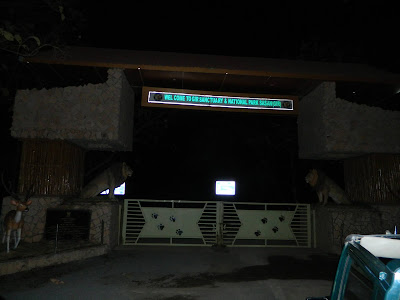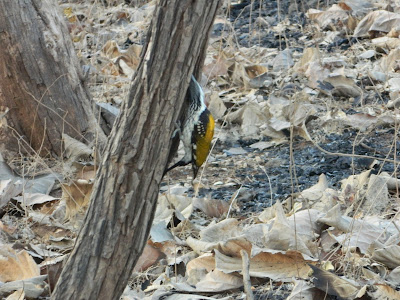It was around 04.30 hrs in the morning. The calling bell with its shrill sound
warned us to get out of the hotel room. As we opened the door, a chilled breeze
with its full blow dashed against our body. It was pitch dark outside. The
solar light of the hotel helped us to identify our driver and guide who were
waiting outside our room with their vehicle parked in a distance.
“Sir, we have to
proceed a little early to be the first entrant in the forest. Are you ready?”
We were already
advised to get ready to reach the forest gate within five o’clock for probable
animal sighting. So we came out in jackets, comforters, and other accessories
including a camera.
Within ten minutes we
reached the entry gate of the forest where the tickets and passes would be
issued. We were so early; still, we were number five in the queue. The ticket
counter was yet to be opened. The guide was standing beside me enquiring our
details and checking the permit paper which was obtained online.
When the next person
arrived, my guide asked me to leave the number five position for him and
advised me to stand in the number six position. When I asked him the reason he
made a signal to keep quiet.
The ticket counter
opened exactly at 05.00 hours and I was issued a ticket
for gate no.6.
Yes, we were going to
enter Gir National Park, the only forest inhabited by Asiatic lions. The forest
is located covering the Gir, Junagadh, and Amreli districts of Gujrat.
Having obtained the
ticket, we proceeded to gate no.6 by our vehicle and stood
in the queue, ready for entry at 5.30 hrs in the morning.
It was still dark as the season was peak winter and late sunrise because the
forest was located in the extreme western part of India.
We could hear the
roaring of lions from outside the gate. The guide explained to me that the
chance of animal sighting was more in the portion where gate no.2
and 6 were located. That was the reason he asked me
to sacrifice the entry ticket for gate no.5.
There were eight gates
and tickets were issued in seriatim and only five vehicles were allowed in each
gate in each session. The first vehicle entering the forest had the chance to
locate animals more than the next vehicle as the forest remained silent
throughout the night.
Since it was dark, we
had to satisfy ourselves watching the area within the visibility of the
headlight of the vehicle. Further, the road was dusty and the movement of our
vehicle created the dust to whirl in the air.
After moving around a
kilometer or so, suddenly there was a shrill sound. Our guide told us to remain
silent as it was a deer call and lion or lioness was expected to be very near.
Within a couple of
minutes, we found few deer crossing the road at the top of their speed around 50 meters ahead of our vehicle. Soon a lioness with its robust
structure appeared from the darkness on our right and moved ahead along the
road. Our vehicle started following but the majestic figure did not bother our
presence. After around 100 meters, the animal took a
ninety-degree turn towards the left and disappeared into the darkness.
We were thoroughly
excited and delighted to have a lion sighting within the first half an hour of
our entry. We could clearly shoot videos and photographs from such a close
distance and it was our first gift of the morning.
Our vehicle started
moving through the forest. By that time, the sky had become clear and we could
see the movement of deer, sambars, jackals, and various types of birds. We
reached a water hole in search of more animals but could not find any.
The duration of our
trip was three hours after which we were to leave the forest for allowing the
next session of animal sighting which would start at 9.00 hrs
in the morning.
On the way, we could
see a few local people on a motorcycle moving the forest in white dresses and
white headgears. It was learnt the people were residents of the villages within
the core area of the forest and they had peaceful co-existence with animals. It
was very common, that these people, mostly tribals, frequently lost their
domestic animals as prey of lions and other carnivorous species of the forest.
One such person in the
two-wheeler told something in the local language and our driver sped up the
vehicle to the highest possible limit. After a few minutes, we reached a spot,
where a pride with a lion, three lionesses, and eight cubs resting under the
shed of the tree. They seemed to be relaxed and our presence did not make them
any change in their behaviour. Only the lion, head of the family, warned us
with its roar, to maintain a safe distance from them. The cubs were inquisitive
to know the details of aliens remaining in the safeguard of their parents.
On our way back, we
could see a single lion, seemed to be aged, and was found to be polishing its
nail on the trunk of a tree. Since it was from a safe distance, we did not take
much time to irritate it.
The scorching heat had
forced other animals to take shelter below the shaded trees and we could see a flock of peacocks and peahens searching for their breakfast in an open field
near a water hole.
Within 500
meters of our exit gate, we could see a young couple of lion and lioness
adoring each other with gestures and sound seemed to be ready for mating.
We did not want to
disturb the young couple and gradually moved towards the gate completing our
successful jungle expedition.
How to Reach Gir
The major railway
station to reach Gir Forest is Veraval which is about 70 km
away from the core area. Though there is a railway station at Sasan Gir only a
few trains stop there. Veraval is the major town near Gir though bus service is
there in two nearby small towns Viz. Sasan Gir and Talala.
There is Keshod
Airport around 40 km from Gir Forest but the service is
not regular. The major airport near Gir is Porbandar which is around 170 km.
Boarding
& Lodging
There are very good
resorts and hotels in the buffer area of Gir National Park which can be booked
online. Few homestays have also come up in Sasan Gir but they are yet to become
popular.
Major stand-alone
restaurants provide vegetarian food with few exceptions. But cuisine with all
types of tastes is available in the hotels and resorts.
Sight Seeing
The major attraction
is Gir National Park with a lion habitation of around 700 along
with some other species of animals. The best sighting time is morning, despite
there are four sessions of trips per day. The tourists can visit nearby tribal
villages and get an idea of their lives and livelihood.
There is also a
separate visit in the caged vehicle in an enclosed area where few lions are
kept in their natural environment.
The tourists can also
make a visit to Somnath Temple (80 km) and the beaches of Diu
(66 km) in the day time.
My experience
Sighting wild animals
in their natural habitat is always a pleasure. The most charming experience
about Gir is that the colour of the soil of the forest and the colour of the skin of the lion is almost similar which has helped the animals to remain camouflaged despite being very near to human beings.
As far as we know,
human beings are not allowed to stay within the core area of the forest. But
Gir National Park is an exception where there are many villages within the core
area where not only the residents stay, but they are communicating to the nearby
towns in their two-wheelers for marketing their products and purchasing
consumables. Sometimes the residents by-passes the wild animals resting on the
roads like we carelessly ignore domesticated animals in the streets.
There are many tiger
reserves in India. But the tour of Gujarat may remain incomplete without a
visit to Gir National Park, the only habitation of the Asiatic lion in India.











Excellent sir... Please carry on
ReplyDeleteThanks. Trying to improve everyday.
Delete